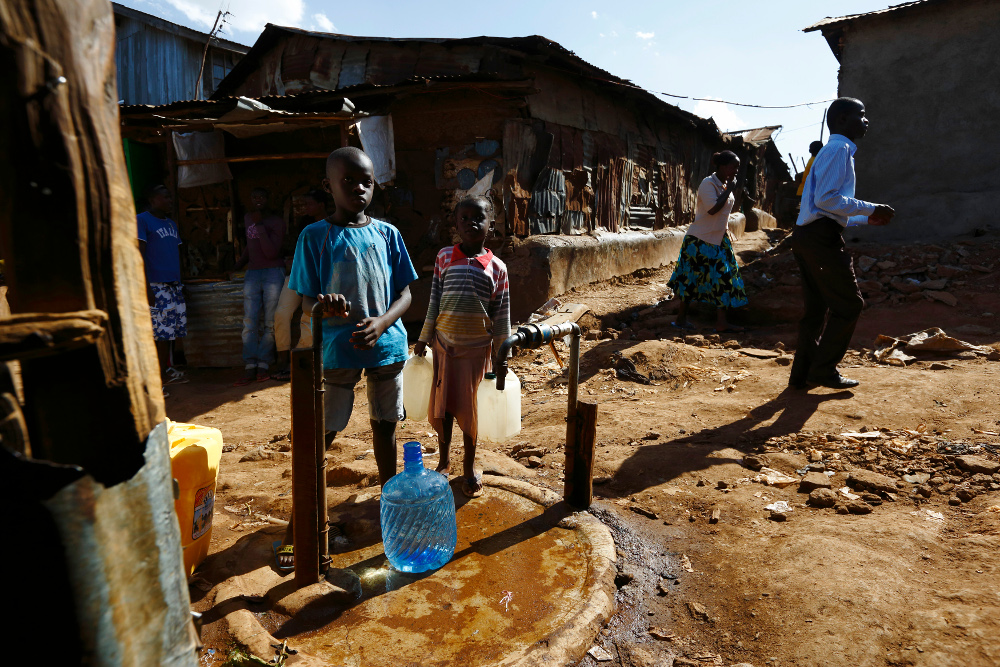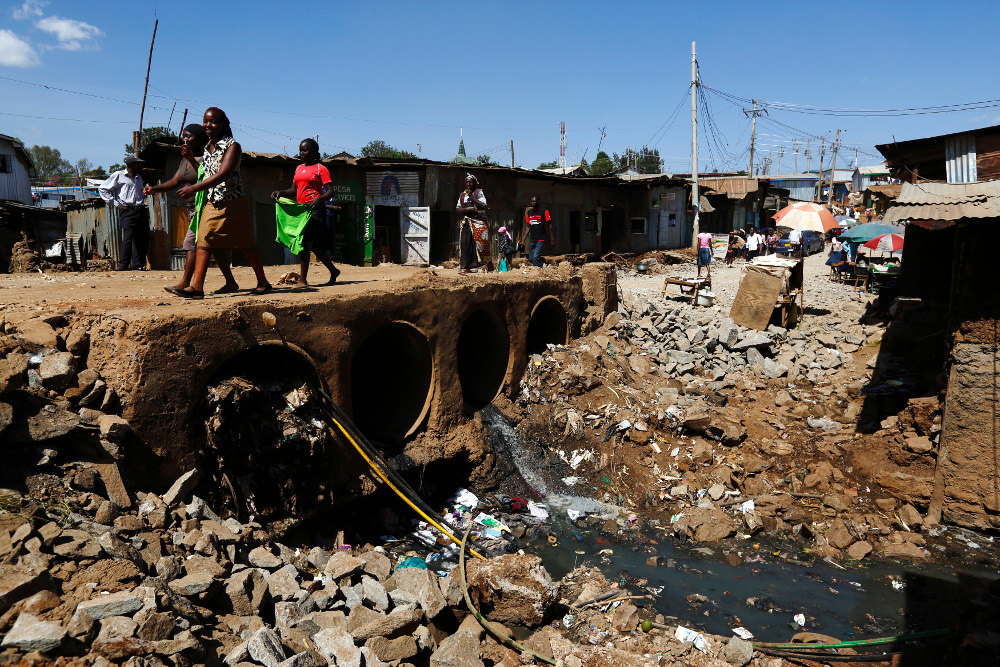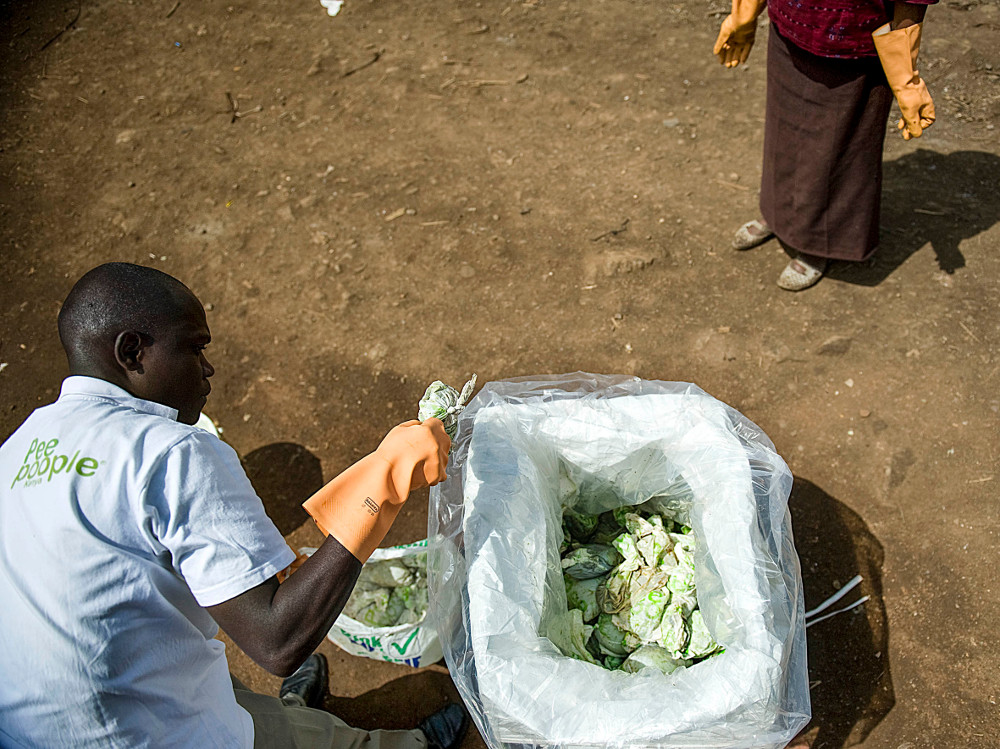Supporters of President Ismaïl Guelleh in 2010 in Djiobuti following Parliament’s approval of the constitutional amendment allowing him to run for a third term.
In the 19 years that Eunice Akinyi has lived in Nairobi’s Kibera slum, her most dramatic day was when a plastic can containing faeces fell on her back from her shack’s roof as she washed her clothes.
Akinyi spits into a clogged drain in the street in front of her home. “I had to run back into my mud hut to remove my stinking clothes. I’m nauseated by the memory of the excrement that ran over my body.”
She pauses. “It wasn’t only the clothes I was wearing that were full of human waste. The excrement also splashed on the clothes I was washing.”
Akinyi is a vegetable seller in Kibera. It is Kenya’s largest slum, with a population of about 300 000 people. According to a 2014 study published in the online open access journal PLoS ONE, about three-quarters of Nairobi’s residents live below the poverty line and up to 80% live in slums or slum-like conditions.
Akinyi later found out the faeces had been placed on her rooftop by a neighbour during the night. He had meant to dump the waste into the street’s open drainage channels but had woken up late.
“Some residents defecate into plastic bags or plastic containers inside their houses and throw the waste on narrow paths and open drains early in the morning,” she says, pointing at the winding paths separating the tin and mud-walled shacks. A strong wind had blown the container off the roof and poured its contents on to Akinyi.

Sanitation problems in Kibera have led to cholera outbreaks. (Darrin Zammit Lupi, Reuters)
Fear of ‘flying toilets’
Falling containers of waste are not all that Kibera’s residents have to fear. Akinyi says some people throw the waste wrapped in plastic bags off their rooftops, a system referred to as “flying toilets”.
Fatuma Ajeeb, a social health worker at the African Medical Research Foundation in Line Saba section, says sanitation is a problem in the slum. Kibera has only a few public toilets and they’re far apart from each other.
“We do not have space to build toilets in every plot. For those who dig pit latrines, they cannot go beyond 3.6m as the water table is high,” says Ajeeb. “On rainy days, the latrines fill up quickly, making flying toilets — a major health hazard — very common.”
Some, like area assistant chief Clement Ombati, believe Kibera’s sanitation problems are the result of poor planning and overcrowding.
Joseph Okere has lived in Silanga village in Kibera for the past 20 years. He says he’s seen several flying toilet-related health disasters over the past two decades.
Bird? Plane? No, flying toilet!
[multimedia source=”http://bhekisisa.org/multimedia/2016-05-16-bird-plane-no-flying-toilet”]
“Water is a scarce commodity and some people tap rain water from rooftops. Unfortunately, some of the human waste thrown as flying toilets would land on rooftops and residents end up consuming contaminated water,” he says. “This results in disease outbreaks during rainy seasons.”
Okere says children who play outside often come into contact with the bags and fiddle with them.Residents don’t want to go outside to relieve themselves at night because of high crime rates, so they opt to use the plastic bags.
Kibera’s sub-county public health officer, Charles Warutere, says cholera outbreaks have been the slum’s biggest problem.
In May last year, Kenyan newspaper The Star reported that four people had died and 37 people were admitted to hospital following an outbreak of cholera that doctors blamed on poor sanitation in the slum.
But now there might be a solution for Kibera’s sanitation problems.

Open sewers in Kibera are prevalent throughout the slum. (Darrin Zammit Lupi, Reuters)
Solution in a Peepoo bag
In October 2010, nonprofit organisation Peepoople Kenya introduced what it describes as “a personal, single-use toilet that sanitises human excretion shortly after use and thereby prevents faeces from contaminating the immediate environment as well as the surrounding ecosystem”.
The Peepoo is a “hygienic bag” that can only be used once. It contains ammonia for self-sanitisation. The bag is designed to be used with a small potty-like seat called a Kiti, which is suitable for children and adults. The user either sits on the Kiti or squats over it to relieve themselves. The bag is then knotted closed, securing the waste inside. Once closed, the contents remain odourless for 12 hours and can be stored inside the house until disposal. Peepoople Kenya has established several points in the slum where people can drop off used bags. The bags are collected at set times and the waste matter is used to produce a safe-to-use fertiliser.
Medina Abakar, the programme manager for Peepoople Kenya, says it was initially difficult to convince residents that the Peepoo is more than simply an improved flying toilet.
“We had to involve community leaders to win over residents,” says Abakar. “We also had to make use of local community radio stations to reach out to residents and educate them about the Peepoo.”
Caroline Achieng, a Kibera mother of two toddlers, says the Peepoo has saved her family money. “I lived in a place where we had to pay five Kenyan shillings [about $0.05] per person each time we used a toilet. I had to pay between KSh20 and KSh30 [between $0.02 and $0.03] every day,” she says. “Now I buy a pack of Peepoo for KSh60 [about $0.60] and we use it for two weeks.”
“Using the Peepoo is good. It is hygienic. I can leave my children with the Peepoo and be comfortable because the elder one knows how to use it,” Achieng says.

A Kibera resident collects the Peepoo bags for disposal. (Getty Images)
Funding shortfall limits distribution
The organisation runs a project targeting educational institutions, especially informal schools in the slums, to inform people about the product. Medina says about 3 000 learners use the Peepoo at schools in Kibera. They have an additional 12 000 to 15 000 other daily users of the Peepoo in the slum.
But Abakar says her organisation has rolled out the Peepoo in only five of Kibera’s 15 villages because of limited funding.
When the project started, it was funded entirely by donors and so packs containing the Kiti and Peepoo bags could be distributed free of charge. But the funding has since decreased and the organisation is now forced to sell the bags, albeit at a price that is below cost. “One pack, which contains 28 Peepoos costs KSh630 [about $6.20], but we sell it to residents at KSh30 [about $0.30] per pack,” Abakar says.
To encourage residents to use the Peepoo, the organisation gives a Kiti to new users, who can then purchase three packs of Peepoo at a time.
But Warutere says the ultimate sanitation solution in Kibera is building more public toilets and heightening security so that residents feel safe to go outside at night. “The government has started great interventions in the slum by putting up over 100 public toilets, a sewer line and a network of storm water drainage system, enhanced garbage collection and lighting to improve security,” he says.
“Even with the benefits that the Peepoo brings to families in the slum, building proper toilets would be the long-term solution. It is embarrassing for adults or teenagers to defecate on the Peepoo inside their houses. Many people use the pretext of taking a bath and ask children and other relatives to step outside the house, when their actual intention is to relieve themselves.”
